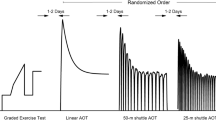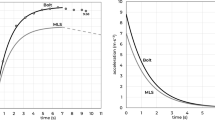Abstract
Purpose
To estimate the energetics and biomechanics of accelerated/decelerated running on flat terrain based on its biomechanical similarity to constant speed running up/down an ‘equivalent slope’ dictated by the forward acceleration (a f).
Methods
Time course of a f allows one to estimate: (1) energy cost of sprint running (C sr), from the known energy cost of uphill/downhill running, and (2) instantaneous (specific) mechanical accelerating power (P sp = a f × speed).
Results
In medium-level sprinters (MLS), C sr and metabolic power requirement (P met = C sr × speed) at the onset of a 100-m dash attain ≈50 J kg−1 m−1, as compared to ≈4 for running at constant speed, and ≈90 W kg−1. For Bolt’s current 100-m world record (9.58 s) the corresponding values attain ≈105 J kg−1 m−1 and ≈200 W kg−1. This approach, as applied by Osgnach et al. (Med Sci Sports Exerc 42:170–178, 2010) to data obtained by video-analysis during soccer games, has been implemented in portable GPS devices (GPEXE©), thus yielding P met throughout the match. Actual O2 consumed, estimated from P met assuming a monoexponential VO2 response (Patent Pending, TV2014A000074), was close to that determined by portable metabolic carts. Peak P sp (W kg−1) was 17.5 and 19.6 for MLS and elite soccer players, and 30 for Bolt. The ratio of horizontal to overall ground reaction force (per kg body mass) was ≈20 % larger, and its angle of application in respect to the horizontal ≈10° smaller, for Bolt, as compared to MLS. Finally, we estimated that, on a 10 % down-sloping track Bolt could cover 100 m in 8.2 s.
Conclusions
The above approach can yield useful information on the bioenergetics and biomechanics of accelerated/decelerated running.













Similar content being viewed by others
Abbreviations
- a(t):
-
Acceleration at time t
- a f :
-
Forward acceleration
- aLa:
-
Alactic oxygen debt
- C 0 :
-
Energy cost of running at constant speed on flat terrain (J kg−1 m−1)
- COM:
-
Centre of mass
- C r :
-
Energy cost of running (J kg−1 m−1)
- C sr :
-
Energy cost of sprint running (J kg−1 m−1)
- Ean:
-
Anaerobic energy
- ED:
-
Equivalent distance: distance covered running at constant speed on flat terrain, for a given energy expenditure
- EDI:
-
Equivalent Distance Index: ratio between ED and actual distance covered
- EM:
-
Equivalent body mass
- ES:
-
Equivalent slope = tan (90 − α)
- F :
-
Force
- F acc :
-
Force acting on the subject during accelerated running: M g′
- F cost :
-
Force acting on the subject during constant speed running: M g
- g :
-
Acceleration of gravity
- g′:
-
Vectorial sum of af and g: \(g^{\prime} = \sqrt {a_{f}^{2} + g^{2} }\)
- H :
-
Horizontal
- i :
-
Incline of the terrain
- k :
-
Constant relating mechanical work against the air resistance (per unit body mass) and speed squared (≈0.0025 J s2 kg−1 m−3)
- M :
-
Body mass
- P g :
-
Mechanical power against gravity
- P req :
-
Metabolic power requirement (in equivalent oxygen units)
- P sp :
-
Specific mechanical power
- P tot :
-
Total mechanical power
- T :
-
Terrain
- v(f):
-
Final velocity
- v(t):
-
Velocity at time t
- VO2 :
-
Oxygen consumption (ml kg−1 min−1 or W kg−1)
- VO2 (s):
-
Oxygen consumption at steady state
- VO2 (t):
-
Oxygen consumption at time t
- VO2eff:
-
Actual oxygen consumption
- VO2max:
-
Maximal oxygen consumption
- VO2T:
-
Theoretical oxygen consumption
- v v :
-
Vertical velocity
- α :
-
Angle between T and H
References
Antonutto G, di Prampero PE (1995) The concept of lactate threshold. A short review. J Sports Med Phys Fitness 35:6–12
Arsac LM (2002) Effects of altitude on the energetics of human best performances in 100-m running: a theoretical analysis. Eur J Appl Physiol 87:78–84
Arsac LM, Locatelli E (2002) Modelling the energetics of 100-m running by using speed curves of world champions. J Appl Physiol 92:1781–1788
Beneke R, Taylor MJD (2010) What gives Bolt the edge: A.V. Hill knew it already. J Biomech 43:2241–2243
Buglione A, di Prampero PE (2013) The energy cost of shuttle running. Eur J Appl Physiol 113:1535–1543
Capelli C, Cautero M, Pogliaghi S (2011) Algorithms, modelling and VO2 kinetics. Eur J Appl Physiol 111:331–342
Cavagna GA, Kaneko M (1977) Mechanical work and efficiency in level walking and running. J Physiol 268:467–481
Cavagna GA, Komarek L, Mazzoleni S (1971) The mechanics of sprint running. J Physiol 217:709–721
di Prampero PE (1981) Energetics of muscular exercise. Rev Physiol Biochem Pharmacol 89:143–222
di Prampero PE (1986) The energy cost of human locomotion on land and in water. Int J Sports Med 7:55–72
di Prampero PE, Piiper J (2003) Effects of shortening velocity and of oxygen consumption on efficiency of contraction in dog gastrocnemius. Eur J Appl Physiol 90:270–274
di Prampero PE, Piñera Limas F, Sassi G (1970) Maximal muscular power, aerobic and anaerobic, in 116 athletes performing at the XIXth Olympic Games in Mexico. Ergonomics 13:665–674
di Prampero PE, Capelli C, Pagliaro P, Antonutto G, Girardis M, Zamparo P, Soule RG (1993) Energetics of best performances in middle-distance running. J Appl Physiol 74:2318–2324
di Prampero PE, Fusi S, Sepulcri L, Morin JB, Belli A, Antonutto G (2005) Sprint running: a new energetic approach. J Exp Biol 208:2809–2816
Fenn WO (1930a) Frictional and kinetic factors in the work of sprint running. Am J Physiol 92:583–611
Fenn WO (1930b) Work against gravity and work due to velocity changes in running. Am J Physiol 93:433–462
Hernandez Gomez JJ, Marquina V, Gomez RW (2013) On the performance of Usain Bolt in the 100 m sprint. Eur J Phys 34:1227–1233
Hoogkamer W, Taboga P, Kram R (2014) Applying the cost of generating force hypothesis to uphill running. PeerJ 2:e482. doi:10.7717/peerj.482
Kersting UG (1998) Biomechanical analysis of the sprinting events. In: Brüggemann G-P, Kszewski D, Müller H (eds) Biomechanical research project Athens 1997. Final report. Meyer & Meyer Sport, Oxford, pp 12–61
Lacour JR, Bourdin M (2015). Factors affecting the energy cost of level running at submaximal speed. Eur J Appl Physiol (in press)
Margaria R (1938) Sulla fisiologia e specialmente sul consumo energetico della marcia e della corsa a varia velocità ed inclinazione del terreno. Atti Acc Naz Lincei 6:299–368
Margaria R, Aghemo P, Rovelli E (1965) Measurement of muscular power (anaerobic) in man. J Appl Physiol 21:1662–1664
Margaria R, di Prampero PE, Derevenco P, Aghemo P, Mariani M (1971) Effect of a steady state exercise on maximal anaerobic power in man. J Appl Physiol 30:885–889
Mero A, Komi PV, Gregor RJ (1992) Biomechanics of sprint running. A review. Sports Med 13:376–392
Minetti AE, Ardigò LP, Saibene F (1994) Mechanical determinants of the minimum energy cost of gradient running in humans. J Exp Biol 195:211–225
Minetti AE, Moia C, Roi GS, Susta D, Ferretti G (2002) Energy cost of walking and running at extreme uphill and downhill slopes. J Appl Physiol 93:1039–1046
Minetti AE, Gaudino P, Seminati E, Cazzola D (2012) The cost of transport of human running is not affected, as in walking, by wide acceleration/deceleration cycles. J Appl Physiol 114:498–503
Morin JB, Bourdin M, Edouard P, Peyrot N, Samozino P, Lacour JR (2012) Mechanical determinants of 100-m sprint running. Eur J Appl Physiol 112:3921–3930
Murase Y, Hoshikawa T, Yasuda N, Ikegami Y, Matsui H (1976) Analysis of the changes in progressive speed during 100-meter dash. In: Komi PV (ed) Biomechanics V-B. University Park Press, Baltimore, pp 200–207
Osgnach C, Poser S, Bernardini R, Rinaldo R, di Prampero PE (2010) Energy cost and metabolic power in elite soccer: a new match analysis approach. Med Sci Sports Exerc 42:170–178
Plamondon A, Roy B (1984) Cinématique et cinétique de la course accélérée. Can J Appl Sport Sci 9:42–52
Pugh LGCE (1970) Oxygen intake in track and treadmill running with observations on the effect of air resistance. J Physiol Lond 207:823–835
Stølen T, Chamari K, Castagna C, Wisløff U (2005) Physiology of soccer: an update. Sports Med 35(6):501–536
Summers RL (1997) Physiology and biophysics of 100-m sprint. News Physiol Sci 12:131–136
Tam E, Rossi H, Moia C, Berardelli C, Rosa G, Capelli C, Ferretti G (2012) Energetics of running in top-level marathon runners from Kenya. Eur J Appl Physiol. doi:10.1007/s00421-012-2357-1
Taylor MJD, Beneke R (2012) Spring mass characteristics of the fastest men on Earth. Int J Sports Med 33:667–670
van Ingen Schenau GJ, Jacobs R, de Koning J (1991) Can cycle power predict sprint running performance? Eur J Appl Physiol 63:255–260
van Ingen Schenau GJ, de Koning JJ, de Groot G (1994) Optimization of sprinting performance in running, cycling and speed skating. Sports Med 17:259–275
Ward-Smith AJ, Radford PF (2000) Investigation of the kinetics of anaerobic metabolism by analysis of the performance of elite sprinters. J Biomech 33:997–1004
Williams SB, Tan H, Usherwood JR, Wilson AM (2009) Pitch then power: limitations to acceleration in quadrupeds. Biol Lett 5:610–613
Wilson AM, Lowe JC, Roskilly K, Hudson PE, Gobalek KA, McNutt JW (2013) Locomotion dynamics of hunting in wild cheetahs. Nature 498:185–189
Acknowledgments
The financial support of Udinese Calcio SpA and of the Lions Club Udine Duomo is gratefully acknowledged.
Conflict of interest
The authors declare to be interested in the commercial development and utilisation of the system GPEXE© (Exelio srl, Udine, Italy).
Author information
Authors and Affiliations
Corresponding author
Additional information
Communicated by Nigel A.S. Taylor.
Rights and permissions
About this article
Cite this article
di Prampero, P.E., Botter, A. & Osgnach, C. The energy cost of sprint running and the role of metabolic power in setting top performances. Eur J Appl Physiol 115, 451–469 (2015). https://doi.org/10.1007/s00421-014-3086-4
Received:
Accepted:
Published:
Issue Date:
DOI: https://doi.org/10.1007/s00421-014-3086-4




